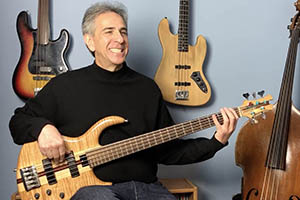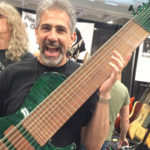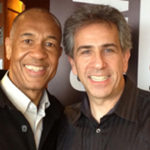Here we go again…
By Jon Liebman
Week of December 9, 2019
This week’s interview, with Joe Santerre, has already gotten a lot of people talking. The longtime Berklee professor, perhaps best known as a master of the 6-string bass, was all but certain to evoke copious amounts of passion and controversy over the age-old question: “How many strings ‘should’ a bass have?”
I’ve commented on the subject before, but my compelling interview with Joe brings to light the different schools of thought on 4-string basses versus “more-than-4-string” basses. Though fives and sixes are typically the most common basses in the extended range milieu, these days it seems the number of strings on a bass is limited only by the imagination and ambition of the luthier building it.
So how many strings do we really need on a bass in order to get the job done?
While the advantages to 5- and 6-string basses are obvious – expanded range, ability to play in position, fewer shift requirements, etc. – they may not be appropriate for certain songs, or even certain styles of music. Interestingly, I’ve occasionally been surprised when 5-stringers have told me they actually opt for the high C over the low B as their choice for a fifth string.
With all that in mind, let’s take the expanded areas one at a time.
Considering the lower register, the ability to extend below the E string seems less “dangerous” in the scope of the bass player’s role. After all, the notes down there are, undeniably, in the bass range. One caveat, though, is to be sure only to venture down to ultra-low territory when it truly serves the song. In other words, don’t do it just because you can!
The upper register is more likely to elicit the angst and ire from bass purists. “It’s no longer a bass,” and “That’s what guitar players are for,” are among the most frequent comments. While there may be some validity to those views, can one totally disclaim the upper range brilliance of John Patitucci, Adam Nitti, and John Myung?
The best answer I can offer is to consider all factors, never losing sight of what the music really needs (pretty much how I feel about any kind of bass playing!). Extended-range instruments should only serve to provide enhancements to the song, where appropriate, and not be pulled out just because they exist. Even without those enhancements, beneficial as they may be, life would still go on in the bass world if they didn’t exist. As the purists are happy to remind the bass community, “Jaco only need 4.”
Have a thought on the subject? Leave a comment below. I’d love to know what you think. In the meantime, check out my interview with Joe here.






AS long as the artist and his or her vision of their music comes first,it’s ultimately up to them whether a 4, 5 and/or 6 string bass will work. Even if a 5 or 6 string bass is called for, as long as the bass is tuned with standard tuning, the E,A,D and G strings are still available. Also, a 4 string bass can be tuned down to have a lower register available. It’s all about serving the artist and their music by laying down an infectious groove, regardless of the string count.
Imagine playing in an early 60’s British Invasion (Beatles, DC5, Kinks, etc.) trio without a rhythm guitarist, or keyboard player. I do. I own 4’s, 5’s, and 6’s. I play a six string in that band tuned BEADGB. I can thumb simple bass lines and play chords at the same time while the guitarist solos. I can also add in some key orchestral lines. One of the most frequent compliments I hear is “I can’t believe there’s only three guys up there.” I’d like to think it’s partially because of my six string bass. My rule of thumb is, the fewer instruments in the band, the more strings I take to the gig. There should be no controversy, it’s purely a case of the right tool for the job.
I have become so comfortable with 5 string basses that a 4 now feels very limiting. I don’t use the low B a lot – but when I do it is the right tool for the job. Even with songs that were originally done on a 4 – there are occasional spots the low note helps. This has been the case in many bands for 20 years now. Done right my band mates have often commented how the low note sounds good.
If someone wants to give an extended range bass a try – my first piece of advice is don’t be afraid of the wider neck. Find a bass as close to standard spacing as possible. You will adapt. To me a 4 string feels like a toy now.
I disagree with anyone who gauges the appropriate number of strings on a bass by what Jaco needed. 1. They are not Jaco, 2. They have probably gone as far as they’re ever going to go as a bass player. 3. They will never fully appreciate the myriad possibilities of this remarkable instrument as it maintains its role as the foundation of musical composition while simultaneously adding choral and other modal tones to really color arrangements. Such narrow mindedness when it comes to bass playing with four strings as an absolute will always limit ones creativity and perhaps what could have been!
“My rule of thumb is, the fewer instruments in the band, the more strings I take to the gig.” Pete, this seems really wise to me. Guitar player just getting into bass. Debating on a 4 string vs a 5. But I often play in a pretty sparse band setup – maybe will stick with the 5 for a bit. thanks!